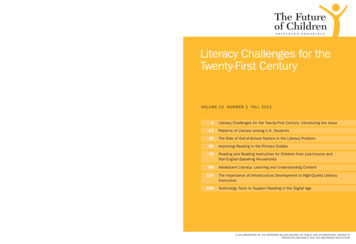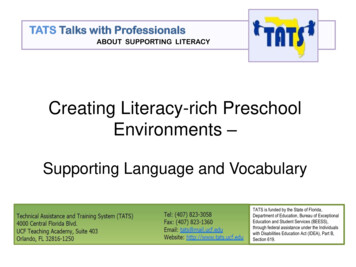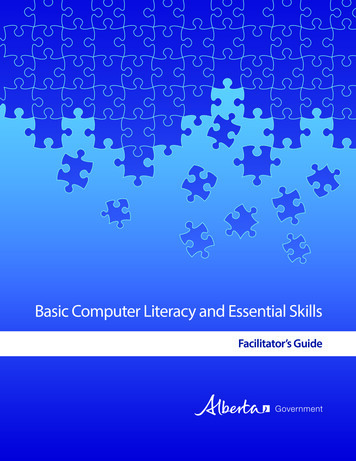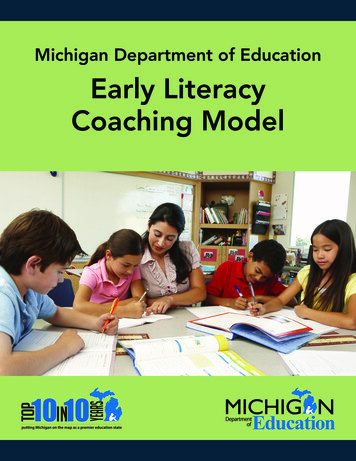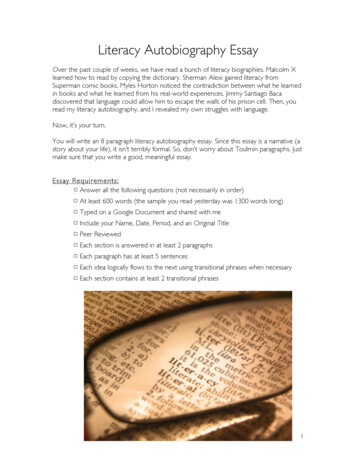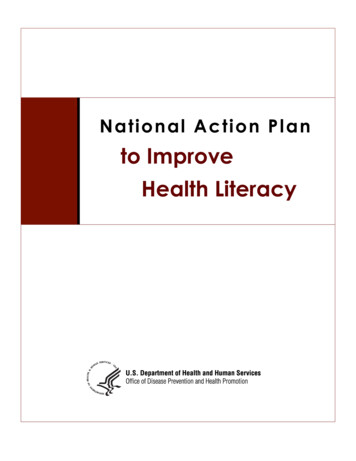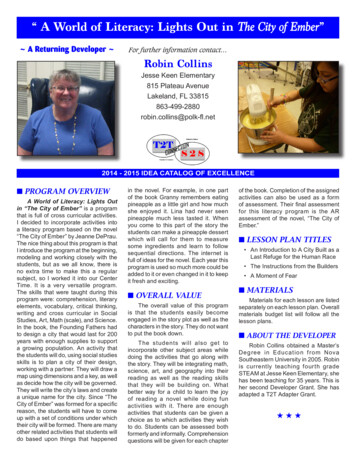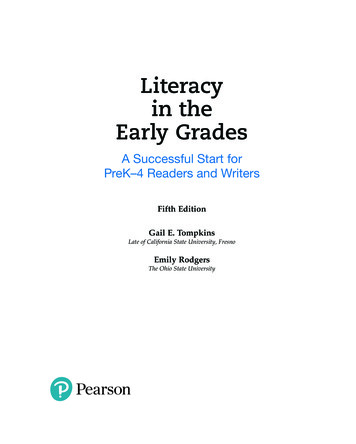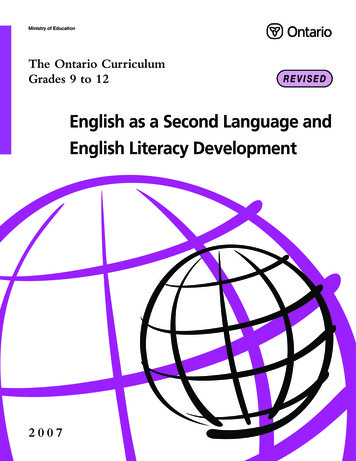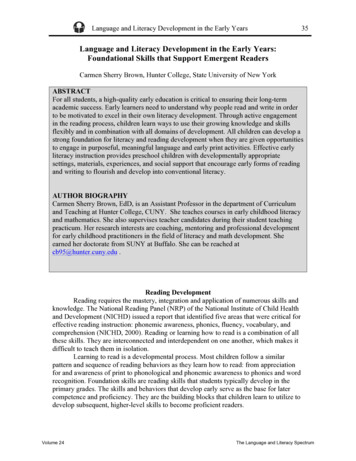
Transcription
Language and Literacy Development in the Early Years35Language and Literacy Development in the Early Years:Foundational Skills that Support Emergent ReadersCarmen Sherry Brown, Hunter College, State University of New YorkABSTRACTFor all students, a high-quality early education is critical to ensuring their long-termacademic success. Early learners need to understand why people read and write in orderto be motivated to excel in their own literacy development. Through active engagementin the reading process, children learn ways to use their growing knowledge and skillsflexibly and in combination with all domains of development. All children can develop astrong foundation for literacy and reading development when they are given opportunitiesto engage in purposeful, meaningful language and early print activities. Effective earlyliteracy instruction provides preschool children with developmentally appropriatesettings, materials, experiences, and social support that encourage early forms of readingand writing to flourish and develop into conventional literacy.AUTHOR BIOGRAPHYCarmen Sherry Brown, EdD, is an Assistant Professor in the department of Curriculumand Teaching at Hunter College, CUNY. She teaches courses in early childhood literacyand mathematics. She also supervises teacher candidates during their student teachingpracticum. Her research interests are coaching, mentoring and professional developmentfor early childhood practitioners in the field of literacy and math development. Sheearned her doctorate from SUNY at Buffalo. She can be reached atcb95@hunter.cuny.edu .Reading DevelopmentReading requires the mastery, integration and application of numerous skills andknowledge. The National Reading Panel (NRP) of the National Institute of Child Healthand Development (NICHD) issued a report that identified five areas that were critical foreffective reading instruction: phonemic awareness, phonics, fluency, vocabulary, andcomprehension (NICHD, 2000). Reading or learning how to read is a combination of allthese skills. They are interconnected and interdependent on one another, which makes itdifficult to teach them in isolation.Learning to read is a developmental process. Most children follow a similarpattern and sequence of reading behaviors as they learn how to read: from appreciationfor and awareness of print to phonological and phonemic awareness to phonics and wordrecognition. Foundation skills are reading skills that students typically develop in theprimary grades. The skills and behaviors that develop early serve as the base for latercompetence and proficiency. They are the building blocks that children learn to utilize todevelop subsequent, higher-level skills to become proficient readers.Volume 24The Language and Literacy Spectrum
Language and Literacy Development in the Early Years36The National Early Literacy Panel (NELP) conducted a synthesis of the scientificresearch on the development of early literacy skills in children ages zero to five. Thepanel's primary purpose was to synthesize research to contribute to decisions ineducational policy and practice that affect early literacy development and to determinehow teachers and families can support young children's language and literacydevelopment (NELP, 2008). The NELP report identified six key predictors for readingand school success. These skills and abilities include alphabet knowledge, phonologicalawareness, rapid automatic naming of letters or numbers, rapid automatic naming ofobjects or colors, writing and phonological memory (NELP, 2008). Children who do notacquire mastery of these skills fall behind their classmates and generally are not readingand comprehending at grade level. NELP also concluded that there are an additional fiveearly literacy skills that are moderately predictive of later literacy achievement: Conceptsabout print, print knowledge, reading readiness, oral language and visual processing.These five skills are usually more predictive of literacy achievement at the end ofKindergarten or beginning of 1st grade than of later reading development (NELP, 2008).The Common Core Reading Standards: Foundational Skills (K-5) have alsooutlined a set of skills that children must master before they can become fluent readersand comprehend what they are reading. The foundational skills are focused ondeveloping students’ understanding and working knowledge of print concepts,phonological awareness, phonics and word recognition, and fluency (NGA and CCSSO,2010). These skills are taught in a developmental sequence to support readingdevelopment. It is important to note that although the NRP identified comprehension andvocabulary as critical components of reading instruction, the Common Core FoundationalSkills do not specifically identify these skills. Vocabulary and comprehension are thefocus of the anchor standards and related grade-specific K-12 Common Core StateStandards. Beginning in kindergarten and through the end-of-high school, comprehensionand vocabulary are integrated across the Common Core strands: Reading, Writing,Speaking and Listening, and Language.To support prekindergarten children in acquiring and mastering the foundationalskills for reading development, effective instruction that is differentiated must beprovided to meet their varied and individual needs. These guided experiences andinstructional approaches must include Common Core Reading Standards FoundationalSkills.New York State Prekindergarten Foundation for the Common CoreThe preparation and foundation for reading success is formed before childrenenter school (National Reading Panel, 2000). Preschool education plays a critical andsignificant role in promoting literacy, preventing reading difficulties, and preparingyoung children for kindergarten.In an effort to provide a clear, comprehensive, and consolidated resource for earlychildhood professionals, the New York State Prekindergarten Learning Standards havebeen revised to fully encompass the New York State P-12 Common Core LearningStandards for English Language Arts and Literacy at the Prekindergarten level. Therevision process has resulted in one document, the New York State PrekindergartenFoundation for the Common Core (NYSED, 2011).The New York State Prekindergarten Foundation for the Common Core isorganized into five broad developmental and interrelated domains: Approaches toVolume 24The Language and Literacy Spectrum
Language and Literacy Development in the Early Years37learning; physical development and health; social and emotional development;communication, language and literacy; and cognition and knowledge of the world. Thesedomains of child development represent the overarching areas of early childhoodeducation that are essential for school and long-term success. The five distinct, but highlyinterrelated domains provide the structure for the New York State PrekindergartenFoundation for the Common Core.Of the five developmental domains in the New York State PrekindergartenFoundation for the Common Core, Domain 4: Communication, language and literacydirectly address how children understand, create, and communicate meaning. Domain 4 isdivided into two sections. Part A – Approaches to communication encompassesmotivation, background knowledge, viewing, representing, and vocabulary. Inprekindergarten, children are expected to demonstrate that they are motivated tocommunicate, are building background knowledge, comprehend what they observe;express ideas using a variety of methods; and demonstrate a growing expressivevocabulary. Part B: English language arts and literacy is aligned with the New York StateCommon Core Learning Standards and includes reading standards for literature andinformational texts; writing, speaking, listening and language standards. With promptingand support, prekindergarten children are expected to ask and answer question aboutdetail(s) in a text, characters and major events in a story and retell familiar stories. Theyare also expected to learn new vocabulary words throughout their interactions with awide variety of texts. With prompting and support, prekindergarten children are expectedto compare and contrast stories with the same topic and make cultural connections to textand self.Part B also includes the reading standards foundational skills. Children inprekindergarten are expected to demonstrate an understanding of the organization andbasic features of print; demonstrate an emerging understanding of spoken words,syllables and sounds; demonstrate emergent phonics and word analysis skills; and displayemergent reading behaviors with purpose and understanding. These expectations areconsistent with the NELP’s findings on the key predictors for reading success.Language, literacy and reading development in the prekindergarten yearsproceeds through several levels of foundational skills with skills and behaviors becomingmore complex and more proficient as children get older. According to the NICHD(2000), foundation skills include three elements: Phonemic awareness — the awareness that spoken words are made up ofindividual sounds (phonemes) and the ability to manipulate these sounds. Knowledge of high-frequency sight words — the most common words, whichstudents should be able to read quickly and automatically. The ability to decode words — to translate a word from print to speech (forexample, by using known sound-symbol correspondences to sound a word out anddecipher it).Prekindergarten Foundation Skills That Support Reading DevelopmentPrint ConceptsPrint awareness is an important part of knowing how to read and write. For preand emergent readers the pictures in books is an important element for developing oralVolume 24The Language and Literacy Spectrum
Language and Literacy Development in the Early Years38language and vocabulary during storybook reading and independent play. Althoughpicture reading reflects a critical stage in literacy development, it is important for childrento understand that print can be read and tells the story. In developing print awareness achild begins to understand what print looks like, how it works, and the fact that printcarries meaning (Strickland & Schickedanz, 2009). Concepts of print refer to the abilityof a child to understand and recognize the ways in which print functions for the purposesof reading, particularly with regard to books. Concepts about print include knowingwhere the front and the back of the book are located; knowing right side up from upsidedown; knowing that the print, not the picture, is what we read; knowing which directionwe read in; and knowing the meaning of punctuation marks.As children are learning about print concepts, they are building the foundation forearly reading development. Knowledge of these concepts is essential to conventionalreading and writing in English. Children with print awareness will begin to understandhow written language is connected to oral language. Oral language skills are linked to thecode-related skills that help word reading to develop and they also provide the foundationfor the development of the more-advanced language skills needed for comprehension(Cain & Oakhill, 2007). Print awareness also supports children’s ability to recognizewords as components of both oral and written communication.The concepts of word are predictive of how well children will be able to read inthe early grades. Concept of word refers to the ability of a reader to match spoken wordsto written words while reading. While developing print awareness, young children willbegan to understand that each word is separate, and that words are separated by a spacewithin each sentence. Using strategies to build concept of word will also supportchildren’s developing awareness of the individual sounds within words. Developingconcept of word precedes and may facilitate the development of phonological andphonemic awareness (Gately, 2004).Concepts of print activities should help students understand the mechanics of atext, and may also emphasize the characteristics of a text, such as capital letters andpunctuation (SEDL, 2008).1. Print Concepts (RF.PK.1)Demonstrate understanding of the organization and basic features of print:a. Follow words from left to right, top to bottom, and page-by-page.b. Recognize that spoken words are represented in written language by specificsequences of letters.c. Understand that words are separated by spaces in print.d. Recognize and name some upper /lowercase letters of the alphabet, especially thosein own name.e. Recognize that letters are grouped to form words.f.Differentiate letters from numerals.Table 1: Supporting print concepts in preschoolVolume 24The Language and Literacy Spectrum
Language and Literacy Development in the Early Years39Classroom/HomeEnvironment Labelclassroom/homematerials withpictures andwords. Useenvironmentalprint to makebooks, games andactivities (e.g.,environmentalprint lotto andmatching) Connectfunctional print toclass/homeactivities (e.g.,daily routine andschedule) Instructional ExampleProvide manyopportunities forchildren to listenand activelyparticipate inread-aloud anddialogic readingactivities Use predictableand patternedbooks Model readingand writingbehaviors Explicitly discusshow a book worksby pointing outthe cover, back,title, authors,illustrators, andfamiliar words ornames, duringread-aloudsessions.Provide a Wordwall, withappropriatepictures andwords, forchildren tointeract withAppropriatetechnology (e.g.,computersoftware, iPad,interactivewhiteboards) thatsupport printawareness andconcepts of printAdult/TeacherGuidance Discuss pagearrangement anddirectionality ofprint withrepeated readingsand modelingwith big books. Take dictationfrom children. Use read aloudsand dialogicreadingexperiences todevelop printconcepts (e.g.,“Show me thefront of the book”“What does theauthor do?”“Show me whereto begin to startreading on thispage.”)Support for ELL Label classroomobjects in homelanguage ofstudents Physically modellanguage to ELLsin classroomroutines andinstructionalactivities. Provide nonEnglish materialswhenever possiblein order to supporta child’s firstlanguage whilethey learn tospeak English. Families shouldbe encouraged toread and talk totheir children intheir nativelanguage.Engage childrenwith materials thatpromoteidentification ofthe letters of thealphabetPhonological AwarenessVolume 24The Language and Literacy Spectrum
Language and Literacy Development in the Early Years40Phonological awareness is the ability to recognize that words are made up of avariety of sound units. Phonological awareness is an umbrella term and encompasses anumber of sound related skills necessary for reading development (Lane, 2007). Aschildren develop phonological awareness they begin to learn that words can besegmented into syllables and each syllable begin with a sound (onset) and ends withanother sound (rime). They also come to understand that words are made up of smallsound units (phonemes) and that these units can be manipulated to form different words.By engaging in language and word play, children learn to recognize patterns amongwords and use this knowledge to read and build words.Phonemic AwarenessReading is a complex and multifaceted process that involves learning acomplicated and often confusing code of letters and sounds known as the alphabeticprinciple. Research has shown that some children struggle with this element of readingdevelopment because they have difficulty with phonemic awareness (NICHD, 2000;NELP, 2008; Shanahan & Lonigan, 2013). Phonemic awareness is a subset ofphonological awareness. Phonemic awareness refers to the ability to recognize, identifyand manipulate phonemes in spoken words. Research has found that this element ofreading is the single strongest indicator for a child’s success at learning to read (NICHD,2000).Phonemic awareness is grounded in oral language and serves as the foundation forreading development. Children who cannot hear and work with the phonemes of spokenwords will have a difficult time learning how to relate these phonemes to graphemes (aletter or a number of letters that represent a phoneme in a word) when they see them inwritten words. This pre-phonics problem interferes with the learning of letter and soundconnections.Knowledge of the alphabet and phonological awareness are both strong predictorsof later decoding and comprehension and teaching these in combination has aconsistently positive impact on improving students’ later decoding and readingcomprehension abilities (Shanahan & Lonigan, 2013). Phonological awareness providesthe foundation for phonics. Phonics, the understanding that sounds and print letters areconnected, is the first step towards conventional reading.2. Phonological Awareness (RF.PK.2)Demonstrate an emerging understanding of spoken words, syllables and sounds(phonemes):a. Engage in language play (e.g. alliterative language, rhyming, sound patterns).b. Recognize and match words that rhyme.c. Demonstrate awareness of relationship between sounds and letters.d. With support and prompting, isolate and pronounce the initial sounds in words.Table 2: Supporting phonological awareness in preschoolClassroom/HomeEnvironmentVolume t for ELLThe Language and Literacy Spectrum
Language and Literacy Development in the Early Years A variety ofbooks thatemphasizerhyming andalliteration (e.g.,Dr. Seuss,repetitive bookswith predictablephrases)Songs, fingerplays and nurseryrhymes displayedon walls and flipcharts.Appropriatetechnology (e.g.,computersoftware, iPad,Interactivewhiteboards) thatsupportsphonological andphonemicawareness Listening games(follow the leader,Simon says) Read books thatcontain rhymingwords,emphasizing therhyming words asyou read Clapping out orusing blocks toseparate words ina sentence Clapping outsyllables inchildren’s names Phonemic awareness: Volume 24 Emphasis on first,medial and endingsounds in CVCwords (e.g., /d/ /o//g/)Segmenting,blending andmanipulatingphonemes (e.g.,“What word doyou get when youchange the /h/ inhat to /c/?”)Teach phonemesalong with letters,not in isolation(e.g., “Peter, Paul,and Penelope allbegin with theProvide activitiesthat follow asequence ofinstructionprogressing fromeasier to moredifficult tasks andfrom larger tosmaller units ofspoken language.Identifying andmaking rhymes(e.g., “Cat, hat,bat are words thatrhyme.”)Dividingsentences intowords (e.g., Whiletalking slowly andmoving a blockfor each word,“The dog barkshas threewords.”) Dividing wordsinto syllables(e.g., Whileemphasizing eachsyllable as youclap, “Ba-by hastwo syllables.) Segmenting andblending onsetsand rimes (e.g., /c//at/ Identifyingbeginning, final,and medialphonemes inspoken words41 Intentionally usevisual models,gestures andmanipulatives tomodel lessons Involve ELLs inpeer andcooperativelearning Provide additionalwork on Englishphonemes that arenot present in thestudents' homelanguage. Provide one-onone support whenpossibleThe Language and Literacy Spectrum
Language and Literacy Development in the Early Years42letter P. They allbegin with the /p/sound.). Segmenting andblendingindividualphonemes inspoken words.Phonics and Word RecognitionResearch has shown that phonics and word study are valuable strategies forimproving children’s ability to recognize words and decode text (Ehri, 2005). The goalsof phonics and word study instruction are to teach children that there are systematicrelationships between letters and sounds, that written words are composed of letterpatterns representing the sounds of spoken words, that recognizing words quickly andaccurately is a way of obtaining meaning from them, and that they can blend sounds toread words and segment words into sounds to spell (NICHD, 2000). Knowing therelationships will help children recognize familiar words automatically and decode orsound out new words (Armbruster et al., 2003).Word recognition is the ability of a reader to recognize written words correctlyand virtually effortlessly. Emergent readers need to learn to recognize high-frequencywords instantly because many of them are not phonically regular. Children must learn toidentify words quickly and fluently so that they can focus on the meaning of what theyare reading (Stanovich, 1986).Words that beginning readers initially sound out through word analysis or phonicscome to be recognized as whole units after readers encounter them repeatedly inconnected text. Effective phonics and word recognition instruction builds steadily onchildren’s understanding and use of both spoken and written language.3. Phonics and Word Recognition (RF.PK.3)Demonstrate emergent phonics and word analysis skills:a. With prompting and support, demonstrate one-to-one letter-sound correspondence byproducing the primary sound of some consonants.b. Recognizes own name and common signs and labels in the environment.Table 3: Supporting phonics and word recognition in preschoolClassroom/HomeEnvironment Identifymeaningful set ofsound-letterVolume 24Adult/TeacherDirected Explicitly teachcommon soundletter relationshipsInstructionalExamples Class books thatchildren createand canSupport for ELL Systematicinstruction andadditional time forThe Language and Literacy Spectrum
Language and Literacy Development in the Early Years43relationships (i.e.,the first letter inchildren’s names) Label personalitems withchildren’s namesthat aremeaningful tochildren Purposely usegames to supportsound-letterconnections (e.g.,tongue twisters)frequentlyinteract with phonics instructionshould be built intoreading programsfor ELLs.Environmentalprint Use wait time toallow childrenenough time toprocess questions Use and encouragethe use of thinkaloud strategies toanalyze and solveproblemsName cardsWord wallAppropriatetechnology (e.g.,computersoftware, iPad,interactivewhiteboards) thatsupport phonicsand wordrecognitioninstructionFluencyReading fluency is related to oral language proficiency (Rasinski, 2003). Childrenshould be encouraged to use oral language for a variety of purposes, such as answeringand asking questions as well as expressing their thoughts. In developing oral languageskills, preschool children demonstrate a wide range of fluency. Oral language provides afoundation where children learn about the alphabetic principle and subsequently learnabout the structure of spoken English words. Oral language development is a term used todescribe the development of knowledge and skills that allow children to understand,speak, and use words to communicate. During the preschool years, children becomefluent in the language spoken at home. With appropriate guidance and support, children’soral language will develop as they begin to use more complex grammar and vocabulary.Children’s oral language skills serve as the foundation for both aspects of reading ability:Word reading and language comprehension (Shanahan & Lonigan, 2013). Oral reading isalso a well-documented method of increasing reading fluency in children (NICHD,2000).Oral language development provides students with the foundation forcomprehending text and communicating effectively. Fluency is inextricably tied todecoding and reading comprehension (Pikulski & Chard, 2005). It serves as the bridgebetween decoding and comprehension.Volume 24The Language and Literacy Spectrum
Language and Literacy Development in the Early Years444. Fluency (RF.PK.3)Displays emergent reading behaviors with purpose and understanding (e.g., pretendreading.Table 4: Supporting fluency in preschoolClassroom/HomeEnvironment Re-readingfamiliar books Model fluentreading Echo reading Appropriatetechnology (e.g.,computersoftware, iPad,interactivewhiteboards,voice recorders)that supportreceptive andexpressivefluencyAdult/TeacherDirected Songs, fingerplays, poetry andnursery rhymescan be used topractice fluency Books on tape,CD or DVDInstructionSupport for ELLExamples Model fluentreading byreading alouddaily. Use expressionwhile reading Read a phrase orsentence aloudthen have childrenrepeat the samephrase or sentence Act out books andstories to provideadditionalopportunities totranslate writtenlanguage to orallanguage. ELLs shouldparticipate ininteractive readalouds Use wait time toallow childrenenough time toprocess questions Listen repeatedlyto books readaloud in order togain fluency inEnglish Identify newvocabulary to preteach beforelesson or activityThe New York State Prekindergarten Foundation for the Common Core willprovide an essential beginning for developing and implementing high quality curriculum,creating meaningful and appropriate learning experiences for four- year-olds across NewYork State, and informing other critical processes such as designing learningenvironments, planning standards based instruction and assessment, as well as pre-serviceand in-service training for administrators and teachers, and results-oriented parentengagement (NYSED, 2011 p.6).AssessmentFoundational skill instruction must include assessment opportunities that measureprogress in the Common Core Foundational Skills. Young children enter kindergartenfrom diverse backgrounds with a variety of skills that it is necessary to developinstruction to their individual strengths and needs. Assessment is used to measuredevelopment and learning, to guide teacher and program planning and decision-making,Volume 24The Language and Literacy Spectrum
Language and Literacy Development in the Early Years45and to report to and communicate with others (McAfee, et.al., 2004). Assessment of earlyliteracy skills is important for identifying children who may need more intensiveinstruction to achieve success with literacy and become proficient readers.The method of authentic evaluation and assessment, which includes observationsof children, structured interviews, and portfolios, is used to monitor the growth andlearning of individual children. A portfolio, with student work samples and otherevidence from multiple sources (e.g., observations, anecdotal notes, parents) that reflectreal-world activities, documents a child’s efforts, interests, progress, and achievement inlanguage and literacy. Authentic evaluation and assessment is vital for curriculumplanning because it supports the creation of appropriate instructional strategies andactivities to support children’s development. Data from multiple sources (i.e.,standardized assessments, observations, portfolios) provide valuable information forplanning whole group, differentiated and individualized instruction.English Language LearnersOral language and literacy development is supported by children’s homelanguage. Children whose home language differs from the language of instruction willneed additional support to build their oral language skills. Research indicates that EnglishLanguage Learners (ELLs) acquire literacy skills in English faster and do better in schoolif they have a strong foundation in their home language (Espinosa, 2008). Foundationalliteracy skills developed in one language often transfer to a second language (CardenasHagan et al., 2007). With appropriate instruction, preschool children can develop many ofthe foundational skills they will need for learning to read, and children in dual languageprograms are no exception. As children continue to develop language and literacy skillsin their home language, those skills provide a scaffold for developing those same skills intheir second language. During the early years, ELL’s development occurs throughmeaningful interactions with others such as instructional conversations and collaborationwith peers.In order to face the challenges that come with a diverse classroom, all educatorsand administrators need to have both pre- and in-service training opportunities inlinguistic and cultural diversity, and in principles of first and second languageacquisition. It is also critical for the early childhood educator to understand the linguisticand cultural backgrounds of their children in order to facilitate learning and build crosscultural understandings with their families.ConclusionA lack of foundation skills is a major cause of poor performance in strugglingreaders (Zorfass & Urbano, 2008). Struggling readers can include students with learningdisabilities, English language learners, and others with diverse reading needs who are atrisk for failure. Children who enter middle school without strong foundation skills willhave difficulty in content areas that require reading, such as English language arts, socialstudies, science, and math (Zorfass & Urbano, 2008).For all students, a high-quality early education is critical to ensuring their longterm academic success. Early learners need to understand why people read and write inorder to be motivated to excel in their own literacy development. Through activeengagement in the reading process, children learn ways to use their growing knowledgeand skills flexibly and in combination with all domains of development. All children canVolume 24The Language and Literacy Spectrum
Language and Literacy Development in the Early Years46develop a strong foundation for literacy and reading development when they are givenopportunities to engage in purposeful, meaningful language and early print activities.Reading is a process that builds upon a wide range of developing skills and is anongoing process. Every child will move through each of the stages of readingdevelopment at their own pace. The foundations of good reading are the same for allchildren, regardless of their gender, background, or special learning needs. Most childrenuse the same processes in learning to read. Some will need more support than others andmay need more instruction in one reading skill than another. Children who have anopportunity to develop basic foundational skills in language and literacy in preschoolenter kindergarten ready to learn to read and write (Ballantyne, Sanderman, &McLaughlin, 2008). With foundational skills
and mathematics. She also supervises teacher candidates during their student teaching practicum. Her research interests are coaching, mentoring and professional development for early childhood practitioners in the field of literacy and math development. She earned her doctorate from SUNY at Buffalo.


